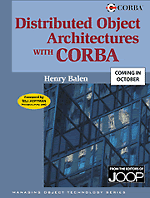Book contents
- Frontmatter
- Contents
- Foreword
- Acknowledgments
- Chapter 1 Introduction
- Chapter 2 Distributed Objects
- Chapter 3 Partitioning, Interfaces, and Granularity
- Chapter 4 Meta-Information
- Chapter 5 Life Cycle And Persistence
- Chapter 6 Transactions
- Chapter 7 Security
- Chapter 8 CORBA and the Internet
- Chapter 9 Architecture Considerations for Deployment
- Appendix: COM/CORBA Integration
- Index
Chapter 3 - Partitioning, Interfaces, and Granularity
Published online by Cambridge University Press: 07 September 2010
- Frontmatter
- Contents
- Foreword
- Acknowledgments
- Chapter 1 Introduction
- Chapter 2 Distributed Objects
- Chapter 3 Partitioning, Interfaces, and Granularity
- Chapter 4 Meta-Information
- Chapter 5 Life Cycle And Persistence
- Chapter 6 Transactions
- Chapter 7 Security
- Chapter 8 CORBA and the Internet
- Chapter 9 Architecture Considerations for Deployment
- Appendix: COM/CORBA Integration
- Index
Summary
Building a system based of distributed objects is not the same as constructing a single object-oriented program. We need to take into account the effects of the network, the fact that we can have tasks interacting while running in parallel, and the possibility of partial failure. Implementing mechanisms to handle failure and coordination of concurrent processes (which will be covered later in the book) may be extremely important; however, the choices we make when designing distributed objects profoundly impacts the performance and flexibility of the system.
It's not enough to take an object model and just distribute arbitrarily, placing objects throughout the network without further consideration. Once we have decided on how to distribute the functionality of the system, we need to spend time and energy defining the interfaces to the distributed objects. Additionally, new users to distributed objects and CORBA commonly encounter problems in identifying the best level of granularity for their distributed objects. Incorrect identification can make the resultant system performance far from satisfactory. Finding alternatives may be too late when you no longer have the time or resources for improvements.
When you initially design your system's distributed objects, you will be concerned with each object's interface, the object model's granularity, and how the complete system is partitioned. The granularity of the object model refers to the scale of abstraction and tasks embodied by the objects and their associated methods.
Information
- Type
- Chapter
- Information
- Distributed Object Architectures with CORBA , pp. 37 - 66Publisher: Cambridge University PressPrint publication year: 2000
